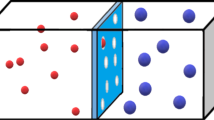Abstract
If no property of a system of many particles discriminates among the particles, they are said to be indistinguishable. This indistinguishability is equivalent to the requirement that the many-particle distribution function and all of the dynamic functions for the system be symmetric. The indistinguishability defined in terms of the discrete symmetry of many-particle functions cannot change in the continuous classical statistical limit in which the number density n and the reciprocal temperature β become small. Thus, microscopic particles like electrons must remain indistinguishable in the classical statistical limit although their behavior can be calculated as if they move following the classical laws of motion. In the classical mechanical limit in which quantum cells of volume (2πħ)3 are reduced to points in the phase space, the partition functionTr{exp(−βĤ) for N identical bosons (fermions) approaches (2πħ)−3N(N!) ∫ ... ∫ d3r1 d3p1 ... d3rN d3pN exp(−βH). The two factors, (2πħ)−3N and (N!)−1, which are often added in anad hoc manner in many books on statistical mechanics, are thus derived from the first principles. The criterion of the classical statistical approximation is that the thermal de Broglie wavelength be much shorter than the interparticle distance irrespective of any translation-invariant interparticle interaction. A new derivation of the Maxwell velocity distribution from Boltzmann's principle is given with the assumption of indistinguishable classical particles.
Similar content being viewed by others
Notes and references
P. A. M. Dirac,Principles of Quantum Mechanics (Oxford University Press, London, 1958), 4th edn., pp. 84–89 and 111–114.
A. Katz,Principles of Statistical Mechanics (Freeman, San Francisco, 1967).
S. Fujita,Statistical and Thermal Physics (Krieger, Malabar, Florida, 1986), Vols. I and II, which will be referred to as I and II.
For example, G. H. Wannier,Statistical Physics (Wiley, New York, 1966), p. 166.
Ref. 1, pp. 207–211.
Ref. 1, pp. 213–214; see II, pp. 117–119 for the classical case.
Ref. 1, pp. 84–89.
For example, D. ter Haar,Elements of Thermostatistics (Holt, Rinehart and Winston, New York, 1966), pp. 64–65.
For example, J. E. Mayer and M. G. Mayer,Statistical Mechanics (Wiley, New York, 1940), p. 40.
See A. Sommerfeld,Thermodynamics and Statistical Mechanics (Academic, New York, 1956), pp. 213–220.
For example, K. Huang,Statistical Mechanics (Wiley, New York, 1967), pp. 192–197.
For example, F. Hund,Geschichte der physikalischen Begriffen 2 (B. I. Wissenschaftsverlag, Mannheim, Germany, 1978), p. 126.
For example, Ref. 12, p. 258; Ref. 13, pp. 197–199.
O. Sachur,Ann. Phys. (Leipzig) 36, 958 (1911);40; 67 (1913); H. Tetrode,Ann. Phys. (Leipzig) 38, 434 (1912).
E. Fermi,Thermodynamics (Dover, New York, 1957), pp. 148–151.
J. W. Gibbs,Scientific Papers of J. Willard Gibbs, I (Dover, New York, 1961), p. 167.
19.For example Ref. 5, pp. 167–170; Ref. 13, pp. 153–155; I, pp. 446–448.
Author information
Authors and Affiliations
Rights and permissions
About this article
Cite this article
Fujita, S. On the indistinguishability of classical particles. Found Phys 21, 439–457 (1991). https://doi.org/10.1007/BF00733357
Received:
Revised:
Issue Date:
DOI: https://doi.org/10.1007/BF00733357



